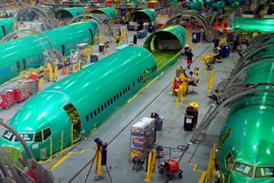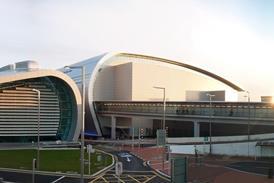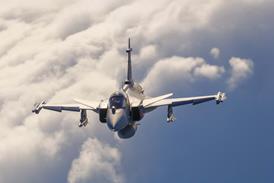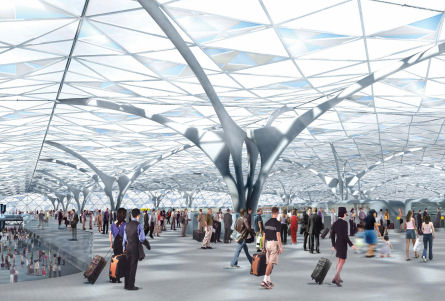Over the past year London Heathrow has been a magnet for criticism. Can the airport's transformation plan help it restore its battered reputation and compete with rival gateways?
Heathrow's chief executive Tony Douglas speaks with infectious enthusiasm about the developments he says will turn Heathrow into a "whole new airport" by 2012. The airport's transformation includes the construction of Terminal 5 and the planned development of another terminal, Heathrow East, initially budgeted at £1.5 billion ($3 billion) and set to replace the ageing Terminals 1 and 2. Terminals 3 and 4 will also be significantly upgraded.
But despite the much-needed terminal capacity these facilities will add, there are concerns that without a third runway, Heathrow could stagnate and fall behind the growth of airports such as Amsterdam Schiphol and Paris Charles de Gaulle (see box page 50).
The first major development taking place at Heathrow is the construction of the £4.3 billion T5, the first phase of which is scheduled to open on 27 March 2008. The T5 complex comprises a main terminal building (T5A), which is five times the size of T4. Two smaller satellite buildings (T5B and T5C) will complete the facility and all three will be linked by underground shuttle trains.
"T5 is a good snapshot of the future of Heathrow as a world-class gateway - it is very much the start rather than the end of the process of transforming Heathrow," says Douglas, adding that the rest of Heathrow's transformation will use T5 as a "minimum standard".
British Airways will be the sole tenant of T5. All but 8% of its Heathrow operations will move to the new terminal. Jonathon Counsell, BA's head of T5 development, says the carrier will move to T5A and T5B in two stages, or "switches" as he prefers to call them.

Switch one will take place in March 2008 and will involve the transfer of all long- and short-haul flights from T1, with the exception of the carrier's Boeing 757 operations, which will remain in T1 ahead of their transfer to T3 at the end of June 2008.
The second switch will take place in April 2008 and will involve transferring all long-haul operations from T4, with the exception of flights operated under BA's joint services agreement with Qantas Airways these flights will move to T3 at the end of October 2008.
Counsell lists a number of reasons for BA's decision not to move all its operations into T5. Firstly, there is not enough room in the new terminal. "When the original plans were drafted all operations were to go in T5, but this assumed our 757 operations would be sold," he says. "The 757s are now staying, but there are not enough widebody stands to accommodate them in T5."
Another reason is that BA wants to be close to its oneworld alliance partners, all of which are co-locating to T3. "It was always planned that we would eventually expand from T5 into T3, and T3 has always been part of our long-term growth strategy," says Counsell, adding that T3's proximity to T5 means it will eventually become "part of the T5 campus" with a planned baggage link between the terminals and an extension of the underground shuttle system.
All T5 passengers will check-in and pass through security on the top floor of T5A. The check-in process will make significant use of self-service kiosks, of which there will be 108. BA is expecting 80% of passengers to check-in online, although there will be 54 traditional check-in desks for those passengers who choose not to do so. A total of 96 fast-bag drops will speed up the check-in process. "Our modelling shows that you will never queue - there will never be more than one person in front of you at the kiosk," boasts Counsell.
The T5 complex will house five BA lounges: three in the main terminal for Gold Card, First Class and Club World passengers and one in each satellite building. The shuttle linking T5B and T5C with the main terminal will depart every 90 seconds.
T5 is described by Counsell as a "once in a generation opportunity" for BA to improve its working practices at its main hub: "Our Heathrow operations are hugely constrained - there is huge complexity and it's very difficult to integrate flights, making it far from ideal. We are currently using Heathrow at 60% more than its design capacity. The central terminal area is like a bunch of cul-de-sacs with dead-end areas to park aircraft, but T5 will have dual taxiways with two ways into each of the 63 stands, a much better utilisation."
Who goes where?
Moving over 90 airlines into different terminals is a major undertaking for Heathrow and its resident carriers. The plan is to co-locate each of the three airline alliances into their own terminals. This will see oneworld carriers occupying T3 alongside non-aligned Virgin Atlantic Airways, while the SkyTeam Alliance has signed a memorandum of understanding to move its operations into T4. Star Alliance carriers will move into T1, although the plan is that they will eventually occupy Heathrow East, if and when it is built.
Douglas says a "baseline plan" has been agreed with all Heathrow's airlines, although he adds that the plan is "complex" and requires "all parties to continue to work together to ensure minimum disruption". The opening of T5 next March will trigger a massive move sequence. The next big step will be how and when the Star carriers start to move from T3 and T2 into T1.
Douglas declines to provide details of which Star carriers will move and when, although Star chief executive Jan Albrecht says lengthy discussions between Star and BAA are close to fruition on an MoU agreeing the planned move to Terminal 1 and later Heathrow East.
Sir Michael Bishop, chairman of Star carrier bmi, describes as "excellent" the concept of upgrading T1 before transferring to Heathrow East. "The reputation of Heathrow has been trashed by a succession of issues over the past year, giving it a very poor perception in the passengers' view," says Bishop, who believes it would only take a few improvements to restore Heathrow's image.
BA's move out of T1 will instantly relieve the pressure on the central terminal area. "This will be last year of Heathrow being a real pressure cooker - the whole feel of the airport will be completely different," says Bishop.
Oneworld's vice-president of customer experience and airports, Kenneth Gilbert, explains that the terminal allocation decision was driven by geography and the size of the facilities: "Oneworld is so large that it couldn't fit in one building, and it was a given that BA would go in T5. With T3 being the closest to T5 it was logical for oneworld partners to occupy T3."
SkyTeam takes Terminal 4
Air France's general manager for the UK and Ireland, Christine Ourmières, notes that the French carrier and its SkyTeam partners are working with BAA to plan their move into T4. "Project designs for T4 are on the table but the final map of what it will look like is still being worked on," she says. Douglas says that SkyTeam will be given a clear picture of BAA's T4 plans shortly. "The potential for a major redevelopment of T4 is one we're exploring in great detail," he says.
Foster & Partners |
|---|
BAA has received outline planning permission for Heathrow East from the London Borough of Hillingdon, and the application is now under review by the Mayor of London's office. Douglas says all dialogue has been "extremely positive" and he expects "a tick in that box in the next few weeks".
If it gets the go-ahead, the first phase of Heathrow East is scheduled to open in June 2012. T2 will be demolished at the end of 2008 and T1 will also close, although there are no imminent plans for its demolition. "When Heathrow East is completed, we will close and mothball T1," says Douglas. "T1 may be demolished at some point in the future, but not at this stage."
BAA is hopeful that Virgin Atlantic will follow Star into Heathrow East. Virgin, however, is noncommittal, saying that a move is "feasible", but the project is "not far enough down the line for a decision to be made".
So what will all this terminal development mean for Heathrow's capacity? The airport now handles about 68 million passengers a year, although demand is forecast to grow to 85 million by 2018 (excluding the potential impact of Europe-US Open Skies), according to Douglas. The first phase of T5 will add terminal capacity for an additional 30 million passengers, rising to 35 million when the second satellite opens in 2010. Heathrow East will add capacity for 30 million passengers, but this replaces, and is slightly less than, the existing combined capacity of T1 and T2. The result is that Heathrow will have enough terminal capacity for about 90 million passengers by 2012.
This can be achieved, says Douglas, without the need for a third runway because larger aircraft, such as the Airbus A380, will mean that more passengers can be carried per flight. However, he admits that beyond the 90 million capacity point, "things get extremely difficult for Heathrow", putting a question mark over its long-term growth.
Virtual tour
See for yourself what Heathrow Terminal 5 will look like: www.flightglobal.com/T5
Will a third runway ever be built?
While London Heathrow's transformation plans are generally seen as a positive thing for the airport's future by its resident carriers, there is growing pressure on airport operator BAA to ensure that plans for the construction of a third runway are put in place as soon as possible to enable the airport to compete with other faster-growing hubs.
British Airways chief executive Willie Walsh says there has "never been a stronger case" for airlines to unite in pushing for a third runway. He believes the recent Open Skies agreement between Europe and the USA means there is a stronger-than-ever economic argument for building a third runway. Virgin Atlantic Airways says there is also an environmental case for an additional runway. "A third runway makes sense from an environmental point of view because it would enable aircraft circling the airport and emitting unnecessary carbon dioxide to land faster," says the carrier.
Air France's general manager for the UK and Ireland, Christine Ourmières, believes that while many changes are taking place at Heathrow over coming years, the real long-term challenge is capacity. "If Heathrow can't expand by adding runways, it will be a huge constraint for them. If you don't run at the same rate as your competitors, what will happen?" she asks, pointing to "benchmark competitors" such as Amsterdam Schiphol, Frankfurt and Paris Charles de Gaulle.
In 2003 the UK government issued a white paper in which it set out options for a third runway as well as the potential for introducing mixed-mode operations (allowing take-offs and landings on both runways rather than dedicating each runway to one mode) at Heathrow. The airport's chief executive Tony Douglas says he expects the government to issue a consultation paper on the proposals later this year. "We will put the case very clearly that Heathrow should seek to benefit from mixed-mode and/or a third runway, but we would have to find a clever solution to address noise and environmental issues in order for permission to be granted," he adds.
Annual aircraft movements at Heathrow are capped at 480,000 and Douglas predicts that 476,000, or 99%, of these will be used this year. He says the introduction of mixed-mode operations could "theoretically" add up to 15% more runway capacity, increasing annual aircraft movements to about 540,000. Ourmières says mixed-mode operations would "provide oxygen" to Heathrow in the medium-term, but points out that it is "not the answer for full competitiveness in the long-term".
Douglas concedes that if Heathrow does not gain additional runway capacity by 2020, "the surplus capacity would go elsewhere". This would then pose the question of whether Heathrow should focus on providing a high-quality service to the long-haul market at the risk of losing short-haul growth to other airports.
The Star Alliance, which celebrated its 10th birthday in mid-May, is as relevant today as it ever was, argue its founding fathers. Visit www.flightglobal.com/ABblogs
For more information about the Airbus A380, please visit our A380 page
Source: Airline Business
























